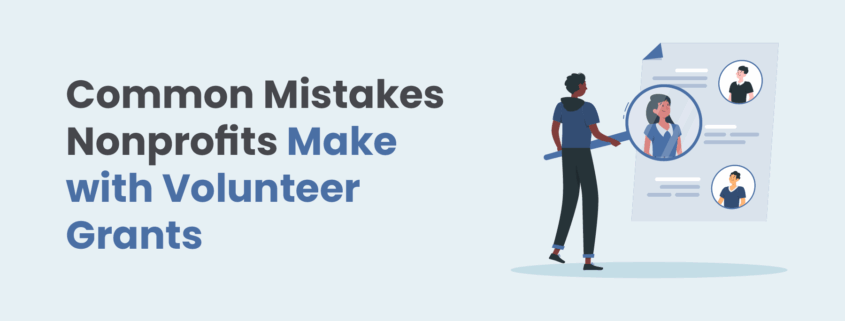Common Mistakes Nonprofits Make with Volunteer Grants
Volunteer grants, also known as Dollars for Doers programs, are an often-overlooked yet powerful way for nonprofits to maximize the impact of their volunteer efforts by turning time into funding. These programs empower companies to donate a certain amount of money to a nonprofit each time an employee volunteers for that organization.
Despite their potential, many nonprofits fail to fully leverage volunteer grants due to common mistakes and misunderstandings. Becoming familiar with these pitfalls and learning how to avoid them can greatly improve the success of your volunteer grant initiatives, ensuring stronger relationships with corporate partners and a healthier funding stream for your organization. We’ll cover some of the most common mistakes nonprofits make with volunteer grants (and how you can overcome them successfully) here.
1. Unfamiliarity with Corporate Volunteer Grant Programs
One of the biggest challenges that nonprofits face is simply not knowing which companies offer volunteer grant programs. Without this knowledge, they may miss out on significant opportunities for funding. Why? Companies with these programs may not advertise them widely, and even if they do, many nonprofits may not be aware of the eligibility requirements or how to access these funds.
Solution: Research and Compile a List of Companies
To overcome this challenge, nonprofits should take a proactive approach. Begin by researching companies that are known for offering volunteer grants. There are several online databases, nonprofit forums, and industry reports that compile lists of companies with active volunteer grant programs.
Additionally, building relationships with your current corporate partners can help, as many organizations already have these programs in place but may not actively communicate them to their nonprofit partners. Once you’ve identified the companies, create and maintain a list to track which organizations offer volunteer grants and what the specific terms are. This resource can then be shared with volunteers to ensure they are aware of the opportunities and can take full advantage of them.
2. Lack of Volunteer Awareness
Even when companies offer volunteer grants, employees often don’t know about them, which means they miss out on the opportunity to request grants for their volunteer hours. Volunteers may not be aware that their company offers these programs or that they can nominate their hours for funding, and this lack of awareness can result in substantial missed revenue for nonprofits.
Solution: Actively Promote Volunteer Grant Opportunities
To encourage participation and bridge this knowledge gap, nonprofits should actively promote volunteer grant programs to their supporters. Start by informing your volunteers about these opportunities through multiple channels: newsletters, emails, social media, and directly at volunteer events or orientations.
It’s important to make the process as clear and simple as possible. Provide step-by-step instructions on how volunteers can apply for grants, including eligibility criteria, the application process, deadlines, and any necessary documentation. By fostering an open line of communication with your volunteers and continuously reminding them about these opportunities, you can significantly increase participation and secure additional funding for your cause.
3. Inaccurate or Outdated Employment Information
Another common mistake is not having up-to-date information on where your volunteers are employed. This lack of knowledge can prevent you from identifying companies that may be willing to contribute volunteer grants based on their employees’ service with your organization.
Solution: Collect and Regularly Update Employment Information
Nonprofits should take proactive steps to gather and maintain accurate, updated employment information for their volunteers. This can be done during volunteer sign-ups, event registrations, or in membership forms. Ask volunteers to share the name of their employer and whether their company offers a volunteer grant program. You can even use an employer append service to help fill in any remaining gaps in your data!
Keeping this information organized and up-to-date in a centralized database will allow you to easily follow up with volunteers about the potential for volunteer time-matching.
4. Disorganized Tracking of Volunteer Hours
Nonprofits often struggle with tracking volunteer hours in a way that makes it easy to report to companies that offer volunteer grants. This lack of organization can lead to missing out on grants or being unable to verify the required volunteer hours when applying for these programs.
Solution: Implement Volunteer Management Software
One of the most effective ways to address this issue is by investing in Volunteer Management Software (or a VMS). This kind of software can automate the process of tracking volunteer hours in real-time, ensuring that you have accurate records when it’s time to submit grant applications. Many VMS platforms allow nonprofits to collect data on volunteer time, categorize activities, and generate reports that make it easy to verify eligibility for volunteer grants. By using technology to streamline this process, you can save time, reduce errors, and ensure that every eligible volunteer hour is counted toward securing additional funding.
5. Noncompliance with Grant Terms and Conditions
Each company that offers volunteer grants has specific terms and conditions that must be followed, such as how the funds are used or how volunteer hours are verified. Failing to comply with these terms can result in penalties, including the loss of the grant or the requirement to return the funds.
Solution: Review Grant Terms and Establish Clear Communication
To prevent noncompliance, nonprofits must carefully review the terms and conditions of each volunteer grant program. Such terms typically outline acceptable uses for the grant, documentation requirements, deadlines, and reporting expectations. By keeping detailed records and establishing a system for tracking deadlines and reporting, nonprofits can avoid accidental noncompliance.
Maintaining clear communication with the grantors is also essential to ensure that all parties are on the same page. Regular communication demonstrates your commitment to transparency and builds trust with corporate partners.
6. Misallocation of Funds
Another pitfall has to do with using volunteer grant funds for purposes that are outside the scope of the grant agreement. Misallocating funds can lead to penalties, damage relationships with corporate partners, and hurt your nonprofit’s credibility overall.
Solution: Maintain Clear and Separate Financial Records
To avoid misallocation, nonprofits should create a system of segregated financial records specifically for each volunteer grant received. Keep detailed logs of how the funds are spent, ensuring that every dollar is allocated according to the grant’s terms. Establish internal checks and balances to ensure that no funds are used for purposes other than those agreed upon in the grant agreement. This kind of financial diligence not only ensures compliance but also helps build a reputation of accountability and integrity, which can attract future funding opportunities.
7. Ineffective Communication with Donors
Nonprofits sometimes neglect to keep donors, including corporate partners, informed about how volunteer grants are being used and what impact the grants have had. This lack of communication can damage relationships and reduce the likelihood of securing future grants.
Solution: Establish a System for Tracking & Reporting Deadlines
Nonprofits should establish a system to track reporting deadlines and requirements for each grant. Timely and detailed reporting, even outside of formal reporting periods, helps build transparency and keeps corporate partners engaged in the nonprofit’s mission. Share progress updates, volunteer success stories, and detailed financial reporting to show the impact of volunteer grant funds. By maintaining an open line of communication with corporate partners, nonprofits can foster goodwill and strengthen future collaboration.
Final Thoughts
By understanding and addressing these common mistakes, nonprofits can significantly enhance the effectiveness of their volunteer grant programs. These initiatives provide a unique opportunity to increase funding and foster deeper relationships with corporate partners. With proactive planning, clear communication, and efficient tracking, nonprofits can maximize the potential of volunteer grants, ensuring they unlock every possible resource to support their mission.
Maximize Your Volunteer Grants with Double the Donation
Want to see how your volunteer grant efforts could translate into measurable revenue growth? With Double the Donation Volunteering, you can increase volunteer participation, guide supporters through volunteer grant submissions, and establish deeper corporate partnerships all in one place, making it easier to uncover hidden opportunities and showcase your program’s impact.
Discover how the right tools can turn volunteer hours into sustainable funding for your mission. Get a demo today!



